📍Shenzhen Observatory-Dapeng
✅The most beautiful coastline recommended by National Geographic, half plank road, half sea
🚗: Drive to No. 4 Beach of Xichong Beach and transfer to a minibus to the top of the mountain
🎫: Free
🕒: 09:00-12:00 14:30-17:30 Closed on Mondays
📍Judiaosha-Dapeng New District
✅Shenzhen's Maldives, with a beautiful glass sea!
🚗: Bus M27 Judiaosha Station
🎫: Partially free
🕒: 24h
📍Luzui Villa-Dapeng New District
✅The filming location of the movie "The Mermaid", with valleys, cliffs, cliffs, reefs, and beaches
🚗: Take M274 to Yangmeikeng Station-take a sightseeing bus (13.8r) or a speedboat (30r) to Luzui Villa
🎫: Free
🕒: 6:00-18:00
📍Yougan Bay-Longgang District
✅Yougan Bay, located on the Nan'ao Peninsula, faces the sea. It is a natural deep-water bay, a super niche glass sea, and comes to It feels like being in Hawaii here, with a sparkling glass sea
🚗: Take E11 to Dapeng Moon Bay, then take a taxi to Nan'ao Yougan Bay Royal Resort Hotel
🎫: Free
🕒: 8:00-18:30
📍Yunhai Square-Yantian District
✅Shenzhen version of the Sky City
🚗: Sanzhoutang Reservoir Yunhai Park Observation Deck (Metro Line 8 Haishan Station Exit B2, take the Yunhai Special Bus)
🎫: Free
🕒: 8:30-18:00 (You can enter the Yunhai Square Library)
📍Shenzhen Bay Park-Nanshan District
Highlights: Siberian seagulls have flown back to Shenzhen! ! Orange sunset at the seaside with coconut trees
🚗: Exit D2 of Shenzhen Bay Park, Line 9
🎫: Free
🕒: 6:00-23:00
📍Shenzhen Happy Harbor-Bao'an District
✅Shenzhen's new landmark, with the popular "Light of the Bay Area" Ferris wheel, overlooking the beauty of the entire Bay Area
🚗: Exit B2 of Linhai Station, Line 5
🎫: Free
🕒: 24h
📍Qianhai Stone Park-Nanshan District
✅Check in at the giant milk dragon, the Ferris wheel lights up at night and is also very beautiful, suitable for picnics and camping
🚗 : Exit E of Guiwan Station on Metro Line 5
🎫: Free
🕒: 24h
📍Sea World-Nanshan District
✅Super chill seaside exhibition hall and cruise
🚗: Exit A of Sea World Station on Line 2
🎫: Free
🕒: 24h
📍Xianhu Botanical Garden-Luohu District
✅Alternative version of Altay🌲Weekend oxygen inhalation and charging holy place
🚗: Exit C3 of Xianhu Road Station on Line 2/8
🎫: 15/person
🕒: 06:00-18:00
People who see this guide will become rich and thin! !
Explore more treasure places with me~
Sign in to join the conversation
Sign InShenzhen is indeed a city suitable for family travel. I took my children to Window of the World and they had a lot of fun.
Experience the diversity of Shenzhen at once, highly recommended for sisters who come to Nanshan on business trips 🌈Citywalk route: Mixc World👉🏻Shenzhen Bay Park👉🏻Shekou Old Street👉🏻Sea World👉🏻Happy Harbor 1⃣️📍First stop Mixc World  A special shopping mall with a block + mall, with many beauties. Take the elevator to the 5th floor, exit the middle passage between Broadway Cinematheque and mstand, the classic camera position of Shenzhen Manhattan, a must-see. Go to the 4th floor to buy a cup of grandma's handmade, longan ice is the signature. After watching🚴🏻 ride a bike to the next stop 2⃣️📍Second stop Shenzhen Bay Park  Shenzhen Bay is the embodiment of romance. Cycling all the way, riding towards Mangrove Bay, overlooking Hong Kong Island and the Bay Bridge, with Nanshan CBD buildings behind, the sunset is golden, the sea is sprinkled with broken diamonds, and the wet and cool sea breeze passes by my ears. It is hard to describe my mood at this moment. I want to be a happy bird, and I stay for a long time and don’t want to leave. Ride to Mangrove Bay MTR station, take the subway to the old street to find food. 3⃣️📍The third stop is Shekou Old Street.  Exit from Dongjiaokou MTR Station Exit A, follow the order below to eat, the route is very smooth. ✔️Xiao Liu Fried Tofu: Dry mixed tofu is so delicious, highly recommended! The sauce is very soulful, kimchi is greasy, and a small portion is enough. ✔️Foshan Master Huang’s Sugar Water: Ginger milk is the signature, made in 3 minutes, spicy and sweet, especially love it. ✔️Bai Caotang: Red bean double skin milk is delicious, the ingredients are so much that they are about to overflow, especially ✔️Hong Kong Dragon Phoenix Bread: Pineapple buns are delicious! ✔️Jiahua Snacks: Rice dumplings and clay pot rice are the signature dishes. Each customer gets one portion. They look delicious, but I couldn’t eat them anymore. ✔️Huang Li Ji Pig Intestine Rolls: When I went there, the pig intestine rolls were sold out. I ordered green bean soup + Yangjiang lao fen, which were also very delicious. Every store in Shekou is quite old-fashioned. The environment is simple, but the human touch is full. It is very worth coming. 4⃣️📍The fourth stop is Sea World.  After eating and drinking, I went to digest the food and rode a bike to Sea World. First, I went to the Huanchuan Square to see the Minghua Ship. For the first time, I was shocked to see a huge ship in the mall. The business district was very lively and the night view was beautiful. Then I walked to the Sea World Culture and Art Center, which is another quiet and chill world. Sit on the steps and listen to the live performance. The singer sings not to talk. Silently blow the sea breeze. Very relaxed, with a lot of thoughts 5⃣️📍The fifth stop is Happy Harbor  If there is still time, the last leg, take the subway🚇 to Happy Harbor Go to see the light of the Bay Area. The Ferris wheel is very romantic from any angle. Take a walk on the beach. The night after get off work is quiet and beautiful ⭐Shenzhen's night view is very beautiful, the architecture is beautiful, the lights are beautiful, the sea view is beautiful, and any shopping mall is adjacent to the beach. I envy it very much as a drifter in Beijing. I can't help but feel what troubles I have when I blow the sea breeze and daze ⭐Another thing I envy is Shenzhen's nightlife. The small streets at 10 o'clock in the evening are bustling, and there are so many varieties of midnight snacks that I can't finish them in a month. I have to sigh that this is life ⭐The above itinerary, from 15:00 to 21:00, lasted 6 hours, and the spirit was fully recharged. I hope everyone can feel the charm of Shenzhen in a limited time
Share a Shenzhen seaside walking route with very blue water! There are beaches! There are coconut trees! Very photogenic 🌊 ✅Route: 💡The symbols between the locations represent the way to get there 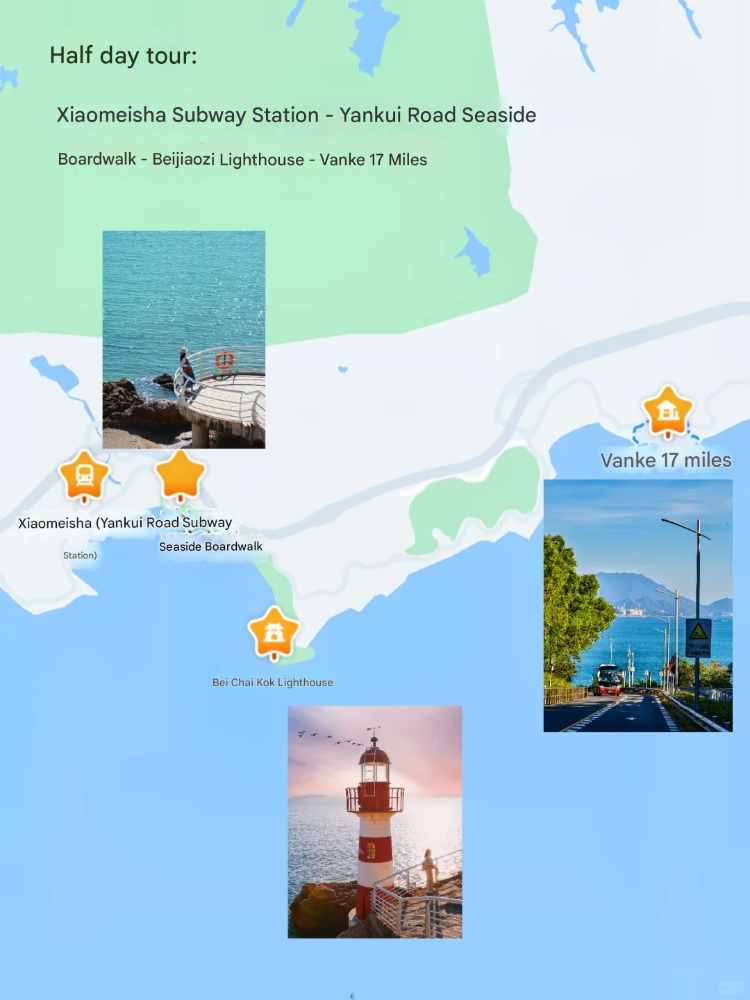 ▪️One-day tour route First take Metro Line 2 to Haishan Station, then check in one by one: Haishan Seaview Park 🚇 Dameisha 🚇 Xiaomeisha Seaside Boardwalk 🚶 Beijiaozi Lighthouse 🚖 Vanke 17 Miles 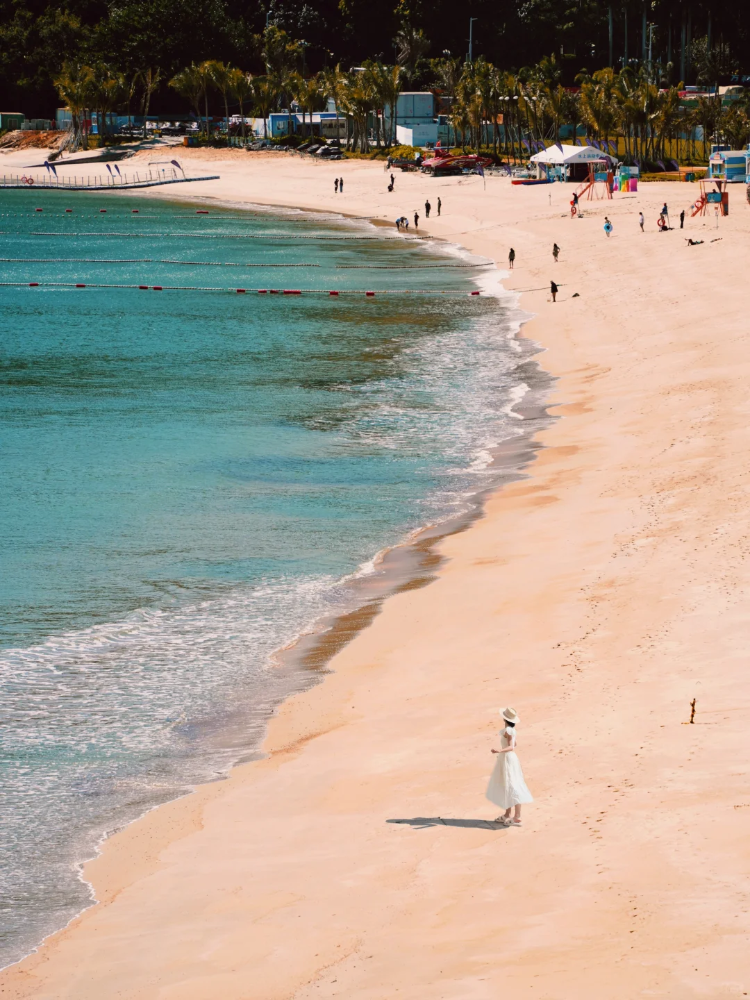 ▪️Half-day tour route Take Metro Line 2 to Xiaomeisha Station, then check in one by one: Xiaomeisha Subway Station 🚶 Xiaomeisha Seaside Boardwalk 🚶 Beijiaozi Lighthouse 🚖 Vanke 17 Miles ✅Check-in points: 📍Haishan Seaview Park: 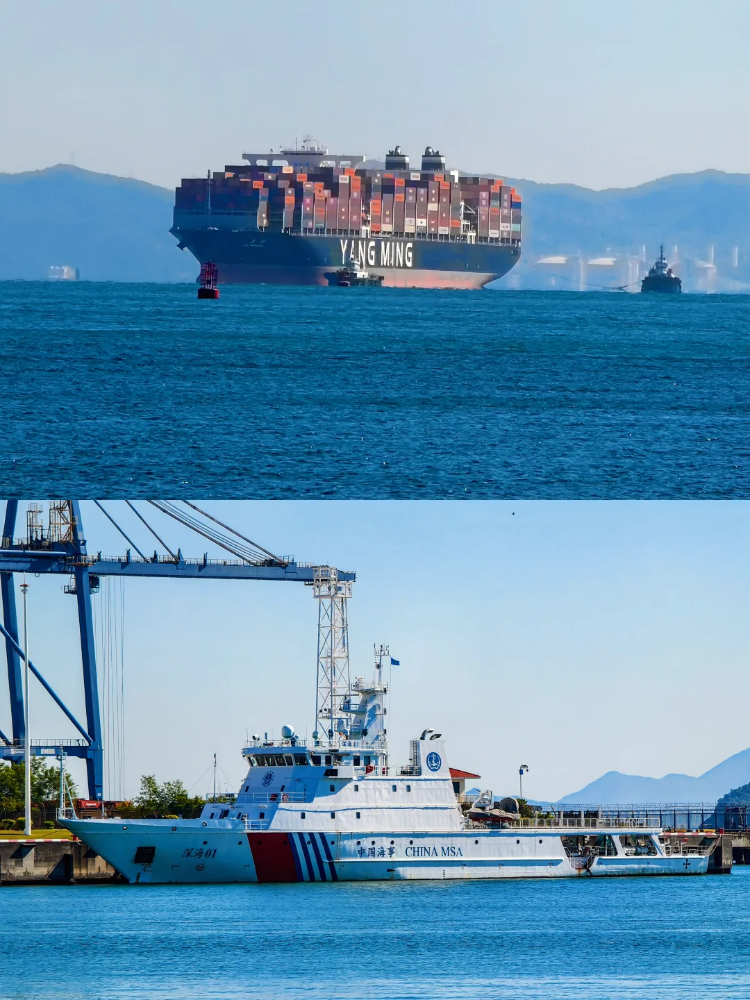 Walk 500 meters from Exit B of Haishan Station, you can take pictures of flowers, big ships, seagulls, and the sea 📍Dameisha : 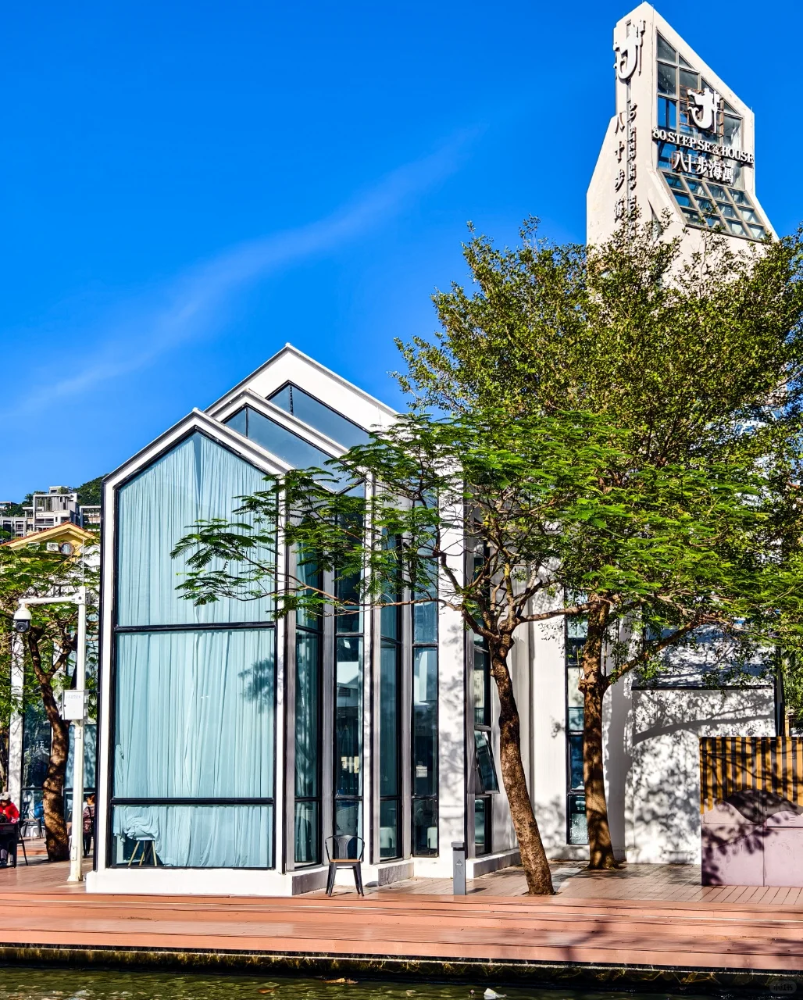 There is a 🆓 beach just outside Dameisha Station, and there is a popular library (Habitat Library) 500 meters away 📍Xiaomeisha Seaside Boardwalk (P3,4,5,11,12): After exiting Xiaomeisha Metro, follow the walking navigation "Yankui Road Seaside Boardwalk", the white boardwalk next to the blue sea 📍Beijiaozi Lighthouse (P6): Walk to the beach from the seaside boardwalk, the scenery on the way is also beautiful 📍Vanke 17 Miles (P1): Arrived 🚖3km from the lighthouse, you can take pictures of the blue sea at the end of the road!
【About attractions】  1️⃣Observatory: Free, gah "Shenzhen Observatory" reservations are required in advance, closed on Mondays, the plank road to the sea, one of the eight most beautiful coastlines in China, very film-worthy 2️⃣Yangmeikeng: Far from the city, it is the filming location of the movie "The Mermaid", with a beautiful coastline and clear and clean sea water 3️⃣Window of the World: Tickets are 220r, opening hours are 9:00-22:30, a miniature landscape theme park that brings together famous attractions from all over the world 4️⃣Dameisha: Free, open all day, a famous seaside bathing beach, with fine sand on the beach 5️⃣Happy Coast: Free entry, some projects require separate charges, a seaside leisure area integrating catering, entertainment and shopping, with beautiful night views 6️⃣Shenzhen Bay Park: Free, open all day, walking in the park with the sea breeze, very pleasant, and also a good place for outdoor activities and parent-child tours 7️⃣Xianhu Botanical Garden: Gate Tickets are 15r, opening hours are 6:00-21:30, there are many kinds of plants, and there are cultural landscapes such as Hongfa Temple 8️⃣ Huaqiangbei: open all day, directly connected by Metro Line 7, not only a paradise for electronic products, but also many special objects, worth visiting 9️⃣ Mixc World: open all day, check in the famous Manhattan camera, high-rise buildings, feel the prosperity of Shenzhen 1️⃣0️⃣ Zhongying Street: open all day, half of Shenzhen, one Half Hong Kong, selling all kinds of duty-free goods, saving time and effort compared to going through customs to Hong Kong 1️⃣1️⃣Sea World: free and open, directly accessible by Metro Line 2, with the "Ming Hua Lun" as the core landscape, unique and a great place to take photos and check in, 1️⃣2️⃣Dongmen Old Street: Foodie paradise, rich variety of snacks [Specific itinerary] # day1: 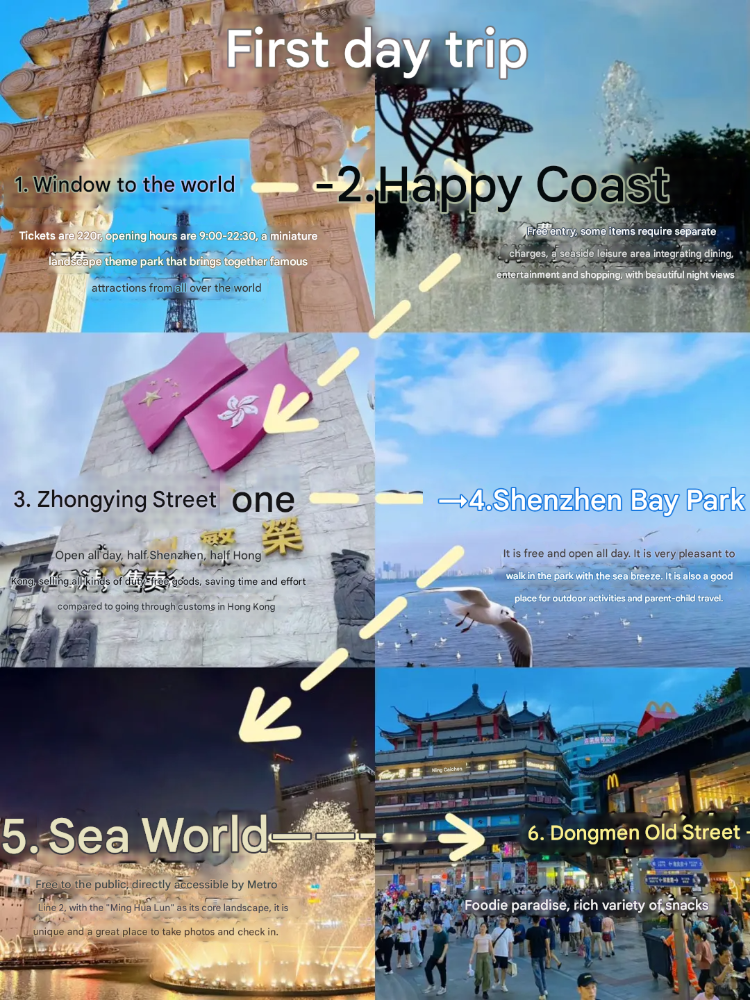 Window of the World➡️Happy Coast➡️Central and British Street➡️Shenzhen Bay Park➡️Sea World➡️ Dongmen Old Street # day2:  Huaqiangbei➡️Vanxiang Tiandi➡️Xianhu Botanical Garden➡️Dameisha➡️Yangmeikeng➡️Observatory [About transportation] ✈️: Shenzhen Bao'an Airport, many routes 🚄: 7 high-speed railway stations, Shenzhen Station, Shenzhen North Station, Futian Station are recommended 🚇The subway is the first choice for urban transportation, many attractions can be directly reached, convenient and cost-effective [About food] Guangdong rice rolls, Cantonese cuisine (suckling pigeon, egg yolk barbecued pork, marinated platter, roast goose), Cantonese breakfast (chicken feet, red rice sausage, durian pastry, shrimp dumplings) clay pot rice, sweet soup Must-eat restaurants: Chao Bazhen, Shanhetian, Fenghao BBQ, Uncle Zhong's glutinous rice cake, Bashu style (Vanxiang Tiandi store), Sister Douhua Peng Restaurant (OCT store)
Xiamen City, abbreviated as "Xia" or "Lu", is a prefecture-level city, a sub-provincial city, a separately planned city, and a Type I large city under the jurisdiction of Fujian Province, China. [164] [198] It is located on the southeastern coast of Fujian Province [186]. It faces the Big and Small Kinmen Islands to the east and Longhai District of Zhangzhou City to the south. It borders Nan'an City of Quanzhou City, Anxi County of Quanzhou City, Changtai District of Zhangzhou City, and Longhai District of Zhangzhou City by land. [207] It has a total area of 1,700.61 square kilometers and the language used is the Minnan dialect. [123] As of the end of 2023, Xiamen City has 6 districts under its jurisdiction; by the end of 2024, the permanent population of Xiamen City is 5.35 million [225]; the Municipal People's Government is located at No. 61 Hubin North Road, Siming District. [204] The territory of Xiamen City consists of the mainland area along Xiamen Bay in the southeast of Fujian Province, as well as the islands of Xiamen Island, Gulangyu Island, and Xiamen Bay. The terrain slopes from northwest to southeast, and is mainly composed of coastal plains, terraces, and hills. It has a subtropical marine monsoon climate, with mild and rainy weather, no severe cold in winter, and no scorching heat in summer. [205] In ancient times, Xiamen Island was a habitat for egrets, so it was also called "Egret Island". During the Western Jin Dynasty, Tong'an County was established. In the 27th year of Hongwu in the Ming Dynasty (1394), Xiamen City was built. In 1935, Xiamen City was established. In 1980, Xiamen Special Economic Zone was established. In 1988, it became a separately planned city. In 1994, it was promoted to a sub-provincial city.
Sanya City is a prefecture-level city under the jurisdiction of Hainan Province. It is located at the southernmost tip of Hainan Island and is known for its tropical climate, beautiful beaches, and luxury resorts. Sanya is one of China's most popular tourist destinations and is often called the "Hawaii of China".
Zhoushan City is a prefecture-level city under the jurisdiction of Zhejiang Province. It is the first prefecture-level city in China established with archipelago system. Zhoushan is located at the intersection of China's eastern golden coastline and the Yangtze River golden waterway, and is China's largest archipelago and an important port city.
Guiyang City, abbreviated as "Zhu", also known as Forest City or Zhu City, is a prefecture-level city and provincial capital under the jurisdiction of Guizhou Province. It is an important central city in Southwest China, a national comprehensive transportation hub city, and is known as "China's Summer Resort Capital".
Weihai is a prefecture-level city in Shandong Province, China, located at the eastern tip of the Shandong Peninsula. The city covers a total area of 5,822.52 square kilometers and has a permanent population of 2.9146 million as of 2024. Weihai has a long history dating back to the Neolithic period and was established as a prefecture-level city in 1987. The city is an important regional center of the Shandong Peninsula, a major marine industry base, and a coastal tourism city as determined by the State Council.
Zhangjiajie City, formerly known as "Dayong", is a prefecture-level city under the jurisdiction of Hunan Province. It is one of the most important tourist cities in China, a national key ecological functional area, and an important ecological barrier in the middle and lower reaches of the Yangtze River. The city has two districts and two counties under its jurisdiction, namely Yongding District, Wulingyuan District, Cili County, and Sangzhi County, with a total area of 9,533 square kilometers. [51] At the end of 2024, the permanent population of Zhangjiajie City was 1.4869 million. [90] Zhangjiajie City is located in the northwest of Hunan Province, in the middle and upper reaches of the Lishui River, and belongs to the hinterland of the Wuling Mountain Area. [1] It is the birthplace and central area of the Hunan-Hubei-Chongqing-Guizhou Revolutionary Base. It was built for tourism. It is the window of Hunan's opening up, the living room for welcoming guests, the leader of all-region tourism, and the beautiful business card of Beautiful China. It is known as "an enlarged bonsai and a shrunken fairyland". [51] In September 1982, Zhangjiajie National Forest Park became China's first national forest park. In August 1988, Zhangjiajie Wulingyuan Scenic Area was listed as a national key scenic spot. In 1992, the Wulingyuan Scenic Area, which consists of three major scenic areas including Zhangjiajie National Forest Park, was listed in the World Natural Heritage List by UNESCO; in February 2004, it was listed in the world's first batch of World Geoparks; in 2007, it was listed in China's first batch of national 5A-level tourist attractions. [2] In 2017, Zhangjiajie City was awarded the honorary title of "National Forest City". [3] In 2024, Zhangjiajie City achieved a regional GDP of 65.44 billion yuan, an increase of 3.9% over the previous year.
Shenzhen City, abbreviated as "Shen", also known as Pengcheng, is a prefecture-level city, a sub-provincial city, a national planned city, and a megacity under the jurisdiction of Guangdong Province. It is a Chinese special economic zone approved by the State Council, a national innovative city, a modern marine city, an international comprehensive transportation hub city, a national economic center, a national advanced manufacturing base, a gateway to the outside world, an important carrier of an international science and technology innovation center, and a pilot demonstration zone of socialism with Chinese characteristics [1] [346-347]. It is located in the southern part of Guangdong Province, on the east bank of the Pearl River Estuary, bordering Daya Bay and Dapeng Bay to the east, the Pearl River Estuary and Lingdingyang to the west, the Hong Kong Special Administrative Region to the south, and Dongguan City and Huizhou City to the north [191]. By the end of 2024, the city will have 9 districts, a total area of 1,997.47 square kilometers, and a permanent population of 17.9895 million [378]. Shenzhen has a 7,000-year history of human activities and a 1,700-year history of city construction [326]. It is a comprehensive landform with hills as the main feature, and a combination of low mountains, hills, plateaus, terraces, and plains [323]. It has a subtropical monsoon climate, with long summers and short winters, mild weather, abundant sunshine, and abundant rainfall [324]. Shenzhen's predecessor was Bao'an County [236] [238] [285]. During the Ming and Qing dynasties, the main part of the city belonged to Xin'an County of Guangzhou Prefecture [234-235]. Before the establishment of the city, it belonged to Huiyang District [239]. The name Shenzhen first appeared in historical records in the eighth year of Yongle in the Ming Dynasty (1410). In March 1979, Bao'an County was renamed Shenzhen City, which was under the dual leadership of Guangdong Province and Huiyang District. In November, it was directly under the leadership of Guangdong Province. On August 26, 1980, Shenzhen established the Shenzhen Special Economic Zone [290] [376]. Shenzhen is one of the key overseas Chinese hometowns in Guangdong Province, one of the important old revolutionary bases, and one of the birthplaces of the Dongjiang Column during the Anti-Japanese War [327-328]; it is a window of China's reform and opening up and an emerging immigrant city, creating the world-renowned "Shenzhen Speed" and is known as the "Silicon Valley of China" [254]; it is also one of the four central cities in the Guangdong-Hong Kong-Macao Greater Bay Area, a national logistics hub, an international science and technology industry innovation center [2], and one of China's three national financial centers [3]. In 2024, Shenzhen's GDP will reach 3680.187 billion yuan, an increase of 5.8% over the previous year
Hangzhou City, referred to as "Hangzhou", was formerly known as Lin'an, Qiantang, and Wulin. It is a prefecture-level city, provincial capital, sub-provincial city, and megacity under the jurisdiction of Zhejiang Province. It is located in the northern part of Zhejiang Province and the lower reaches of the Qiantang River. It is a city in the central area of the Yangtze River Delta [160] and a global financial technology center [162-164]. As of the end of 2024, Hangzhou City has 10 districts, 2 counties, and administers 1 county-level city, with a total area of 16,850 square kilometers. As of the end of 2024, the permanent population of Hangzhou City is 12.624 million. [170] Hangzhou City has a subtropical monsoon climate with distinct four seasons, sufficient sunshine, abundant rainfall, short spring and autumn, and long winter and summer. The terrain of the city gradually decreases from west to east, with low mountains and hills, river valley basins, and accumulation plains. [140] [143] After the Qin Dynasty unified the six kingdoms, it established a county seat at the foot of Lingyin Mountain, called Qiantang. In 589, Qiantang County was abolished and Hangzhou was established. The name Hangzhou appeared for the first time in history. In 1912, the former Qiantang and Renhe counties were merged into Hangzhou County. In 1927, Hangzhou City was established by dividing the urban area of Hangzhou County and other areas. [144] Hangzhou City is an important central city in eastern China approved by the State Council, a national historical and cultural city, an international comprehensive transportation hub city, a national digital economy innovation center and a regional science and technology innovation highland, an advanced manufacturing base, an eastern modern service industry center, and an international tourist destination. [1] [147] Hangzhou is known as the "paradise on earth" for its beautiful scenery, represented by the West Lake culture, Qiantang River culture, and canal culture. [145] The excavation of the Kuahuqiao site in Hangzhou City shows that humans have lived and multiplied here as early as more than 8,000 years ago. The Liangzhu culture, which dates back more than 5,000 years, is known as the "dawn of Chinese civilization." Hangzhou City is an important birthplace of Chinese civilization and is known as the "famous county in the southeast." The Wuyue Kingdom of the Five Dynasties and the Southern Song Dynasty established their capitals in Hangzhou. [144] In 2024, Hangzhou's GDP will reach RMB 2,186 billion, a year-on-year increase of 4.7%.